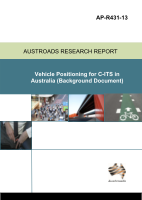Connected and Automated Vehicles

- Publication no: AP-R431-13
- ISBN: 978-1-921991-92-9
- Published: 29 April 2013
- PDF (free) Download
This report discusses the potential positioning requirements needed to be addressed by Australian governments in order for Australia to commence positioning itself to be ready to be a fast adopter of C-ITS platforms and applications being researched and developed internationally.
It is noted that the key regions where C-ITS applications are being researched and developed currently have access to a Space Based Augmentation System (SBAS) (Europe through EGNOS and USA through WAAS). SBAS coverage enables these regions to have access to high accuracy and integrity positioning systems. Australia does not currently have access to a wide area augmented positioning service, such as an SBAS.
The key conclusion of this report is that Australia should continue to engage with international regions working on C-ITS. The Australian C-ITS program should encourage industry and government involvement with and observations of key international C-ITS projects working in the positioning area. The Australian C-ITS program should engage with the spatial industry to ensure that the needs of C-ITS are considered in the development of plans and strategies regarding positioning services for Australia. Of particular focus for C-ITS should be augmented GNSS coverage of Australia.
- Summary
- 1. Introduction
- 2. Positioning Requirements for C-ITS
- 2.1. Review of C-ITS Safety Applications
- 2.1.1. US Developments in C-ITS Safety Applications
- 2.1.2. European Developments in C-ITS Safety Applications
- 2.2. Required Navigation Performance (RNP) Parameters
- 2.2.1. Accuracy
- 2.2.2. Integrity
- 2.2.3. Continuity
- 2.2.4. Availability
- 2.2.5. Interoperability
- 2.2.6. Timeliness
- 2.2.7. Overview of RNP Parameters
- 2.3. Levels of Positioning Accuracy Required for C-ITS Safety Applications
- 2.3.1. Road-level: On Which Road the Vehicle is Placed
- 2.3.2. Lane-level: Which Lane the Vehicle is in
- 2.3.3. Where-in-lane-level: Where the Vehicle is in the Lane
- 2.4. Required Timeliness of Position Data for C-ITS Safety Applications
- 2.5. What Does this Mean for Australia?
- 3. State-of-Play in Satellite Navigation Systems and Support Infrastructure for Australia
- 3.1. Current State of Global Navigation Satellite Systems and Space Based Augmentation Systems
- 3.1.1. Global Navigation Satellite Systems
- 3.1.2. Space Based Augmentation Systems
- 3.2. Current State of Australian National Positioning Infrastructure
- 3.2.1. Ground-based Regional Augmentation Systems (GRAS) and Ground-based Augmentation Systems (GBAS)
- 3.2.2. Continuous Operating Reference Stations (CORS) Ground-based Infrastructure
- 3.2.3. The International GNSS Service
- 3.2.4. Improved Positioning Opportunities Over the Next Decade
- 3.3. A Space Based Augmentation System (SBAS) for Australia
- 3.3.1. The Case for SBAS Coverage of Australia
- 3.3.2. The Type of SBAS for Australia
- 3.3.3. Potential Business Case to Justify Investment in an Australian-owned and Operated SBAS
- 3.3.4. Amalgamation with Japan’s MSAS
- 3.3.5. Integrated SBAS
- 3.4. National Space Industry Policy
- 3.4.1. Infrastructure Plan
- 3.4.2. Australian Strategic Plan for GNSS
- 3.5. The Need to Negotiate with Key Peak Bodies in the GNSS Space
- 3.6. What Does this Mean for Australia?
- 4. Potential Positioning Technological Solutions for C-ITS Applications
- 4.1. Available Positioning Techniques and Their Accuracy
- 4.2. C-ITS Vehicle Positioning Research Projects
- 4.3. What Does this Mean for Australia?
- 5. Protocols and Standards of the Data Communication Media Used to Support Vehicle Positioning
- 5.1. Protocols and Standards
- 5.2. What Does this Mean for Australia?
- 6. Required Resources in the Field of C-ITS Positioning
- 6.1. Required Resources, Capabilities and Skills
- 6.2. Field Operational Tests
- 6.3. What Does this Mean for Australia?
- 7. Conclusions
- References
- Appendix A National Space Industry Policy
- Appendix B Key Australian Peak Bodies With Respect to GNSS
- Appendix C GNSS Based Positioning Techniques
- C.1 Technique A: Standalone GNSS Absolute Positioning and V2V Relative Positioning with Low Cost GNSS Receivers
- C.2 Technique B: SBAS Absolute Positioning and/or V2V Relative Positioning with Low Cost GNSS Receivers
- C.3 Technique C: Smoothed DGNSS Absolute Positioning and/or V2V Relative Positioning with Low Cost GNSS Receivers
- C.4 Technique D: RTK Positioning with Dual Frequency Receivers
- C.5 Technique E: Precise Point Positioning (PPP) and V2V Relative Positioning with Medium/High End GNSS Receivers
- Appendix D Onboard Sensors for use in Positioning in C-ITS
- Appendix E Terrestrial Positioning Constellations (Roadside Infrastructure)
- E.1 Radio Location Technology
- E.2 Wireless Local Area Networks Based Positioning Technologies
- E.3 Overview of Terrestrial Positioning Constellations
- Appendix F Map Matching
- Appendix G Possible Hybrid Vehicle Positioning System Solutions for Australia
- G.1 Prediction of Costs of Vehicle Positioning Components
- G.2 Discussion on Hybrid Positioning Options
- Appendix H Communication Media Available for V2X Communications
- Appendix I Resources, Capabilities and Skills Required for Deployment and Operation of Space Based and Ground Based Positioning Infrastructures
- I.1 Space
- I.1.1 Resources
- I.1.2 Capabilities
- I.1.3 Skills
- I.2 Ground Based Infrastructure
- I.2.1 Resources
- I.2.2 Capabilities
- I.3 C-ITS User Segment
- I.3.1 Capabilities
- I.3.2 Skills
- Glossary
